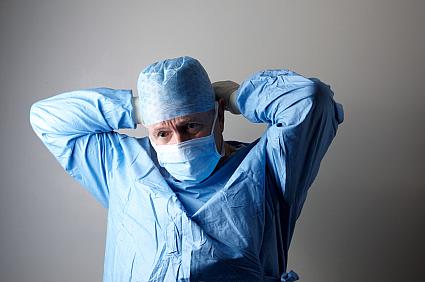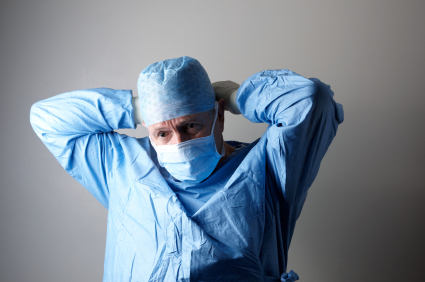Superbugs may show up wearing hospital scrubs

 On Monday, Dr. David C. Martin, a retired Sacramento anesthesiologist, introduced the idea that the public should be on the watch for health care workers wearing hospital scrubs outside of a medical setting, especially in restaurants. The response - especially from his fellow physicians - has been so strong that I am putting together a post based on people's comments for next Monday. Martin's plea for a public health response continues below.
On Monday, Dr. David C. Martin, a retired Sacramento anesthesiologist, introduced the idea that the public should be on the watch for health care workers wearing hospital scrubs outside of a medical setting, especially in restaurants. The response - especially from his fellow physicians - has been so strong that I am putting together a post based on people's comments for next Monday. Martin's plea for a public health response continues below.
Scrubs are generally worn and laundered inside hospitals, in part to keep dangerous pathogens from colonizing the community at large. Such pathogens include the so-called superbugs, such as Clostridium difficile (C. Diff.), Methicillin-resistant Staphylococcus aureus (MRSA) and Vancomycin-resistant enterococcus (VRE). These virulent bacteria have developed resistance to our strongest antibiotics, rendering infection from them difficult, and sometimes impossible to treat.
Superbugs were previously of concern only to those receiving care within hospitals. These bacteria are now implicated in numerous community-acquired infections, some of which may be fatal. Yet some healthcare workers choose to move about routinely in scrubs, between hospitals and coffee houses, restaurants, and local shops, where they may spread dangerous organisms to tables, dinnerware and a multitude of items that are subsequently handled by many others. Furthermore, these superbugs are not eliminated by routine cleaning products, and survive on ordinary surfaces for weeks to months, where many others can pick them up unknowingly.
A recent study by researchers at Cincinnati Children's Hospital Medical Center found that the number of children diagnosed with C. Diff had risen by 15% annually from 1997 to 2006. The Infectious Diseases Society of America speculates that environmental exposure to this pathogen may be partly to blame.
So why would hospital staff members carelessly transport it from hospitals to the community at large?
MRSA infection used to be seen only in hospitalized patients, but it now occurs more frequently in the general population. These bacteria survive for weeks to months on clothing and other common surfaces. Well-crafted medical studies reveal that an increasing number of people are being sickened, and some are dying, from these pathogens, which are highly resistant to modern antibiotics. It has also been shown that healthcare professionals who enter a hospital room occupied by a MRSA-infected patient will frequently acquire MRSA on his/her clothing, without actually touching the infected patient.
A few experts will argue that the use of hospital-exposed scrubs in public has never been proven as the direct cause of a single infection. Strictly speaking, this is true. The chair of the Committee to Reduce Infection Death (RID) dubbed scrubs "a germy, deadly mess" in The Wall Street Journal. Most evidence suggests that the truth is somewhere in between these extremes. As this issue comes under further scrutiny and more-detailed understanding, let's invoke common sense and respect what we don't fully understand. Only after it is proven that scrubs in public cannot spread disease to others can we legitimately support the practice.
It has been credibly estimated that over 100,000 deaths occur each year in the US from preventable medical mistakes. It has also been observed that such high mortality would never be tolerated in the airline industry, which falls under intense scrutiny for mishaps resulting in tens or hundreds of deaths. Why should there be a difference in transparency between these two industries, both of which exercise control over our safety?
Most of us feel quite safe when we fly, even in these turbulent times, but I think most people would speak up if they noticed a public danger while boarding an airplane. So why not voice concern when we see a threat to our health? Why not push back and question when something seems amiss, even if we are unsure? Public accountability and trust are not incompatible in the airline industry; why should they be in at odds in healthcare?
I believe we will ultimately feel safer, while trusting and respecting our caregivers even more, if we collectively take a more active role in improving healthcare practice ourselves. The antiquated notion that physicians and nurses should be solely responsible for healthcare safety is naïve in today's complex and technologically advanced society.
It is also unfair to the healthcare providers themselves, who have more than enough responsibility keeping up with innovative change and long, challenging workdays. Revisiting my aforementioned restaurant, had someone walked through the door without shirts or shoes, they would have been ushered out in mere seconds, and appropriately so. But walking in wearing scrubs, which presents a greater potential threat, is tolerated without question. This is a cultural practice that needs to change.
Next: Scrub scrapping starts with an uncomfortable conversation
Related Posts:

